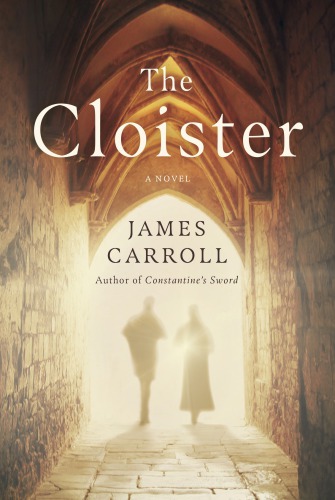
The Cloister
A Novel
کتاب های مرتبط
- اطلاعات
- نقد و بررسی
- دیدگاه کاربران
نقد و بررسی

January 1, 2018
Of faith, doubt, and sorrow: Carroll (Warburg in Rome, 2014, etc.) delivers another religiously charged novel, and a fine one at that.Former priest Carroll blends his well-aired interests in history, theology, and literary fiction in this deftly told story that partakes richly of all. He opens with a familiar but entirely appropriate episode in church history and, as it happens, one of the world's great love stories: the doomed affair of Abelard and Heloise, a story that Carroll complicates with a part that is less well known than Abelard's mutilation and Heloise's cloistering, namely Abelard's defense of the Jews of Mainz. "Jews be damned," thunders an inquisitory abbot. "The battle now is for Peter's eternal salvation." Fast-forward to New York 800 years later, when a conflicted priest from a working-class parish decides to duck into a place not often visited by most working-class Catholics of Inwood, the Cloisters, its architectural elements "tastefully reassembled to evoke the high romance of Gothic revival that had so quickened the patrician imagination of the Gilded Age." There, Michael Kavanagh meets Rachel Vedette, an alluring docent who is whip-smart, deep in reflection on the apostate Simone Weil, and harboring a few secrets of her own having to do with the intersection of and conflicts between the Jewish and Christian worlds. As Rachel slowly unveils her story, Michael comes into conflict himself with the inquisitory Catholic hierarchy--and not just over intellectual matters and questions of faith. As he and Rachel recapitulate elements of that foundational Abelard and Heloise tale, always close to the possibility of tragedy, Carroll brings in a range of issues: the place of excommunicants in a supposedly forgiving church ("In our day," one sagely remarks, "Abelard's misfortunes wouldn't have qualified as a priest's spiritual reading"), the trauma and terror of priestly sexual abuse, the soul-shattering Holocaust that has so recently ended.You don't have to be Catholic--or Jewish, for that matter--to appreciate Carroll's story, though it probably helps. A rich, literate tale well told.
COPYRIGHT(2018) Kirkus Reviews, ALL RIGHTS RESERVED.

January 29, 2018
Carroll’s latest novel (after Warburg in Rome) is a sweeping, heartbreaking blend of history and fiction. In 1142 in the Duchy of Bourgogne, the aging Abbess Héloïse finds the dead body of her former lover, Peter Abelard. This story line is woven together with the 1950 story of Father Michael Kavanagh, a New York priest, and Rachel Vedette, a museum docent. They meet when he takes shelter from a rainstorm in the Cloisters at the top of Manhattan, where Rachel works. Over multiple meetings, the two build a rapport; back in the 12th century, Peter and Héloïse’s love story unfolds. Rachel and Michael are both haunted by people from their pasts—her now-dead father, whose life’s work was an unfinished book on Abelard, and his lost friend from seminary. As Michael discovers his friend’s secrets and Rachel deals with her complicated feelings about her father, Héloïse and Peter’s troubles escalate. The entwined stories move at an engrossing rhythm, making this a very magnetic, satisfying novel.

December 1, 2017
Fascinating in its evocation of the twelfth-century Catholic Church in France, this lavishly detailed historical novel serves as an education in historical philosophy, a poignant tale of devoted love, and a portrait of a postwar human crisis influenced heavily by both. Carroll, prolific author of both fiction (Warburg in Rome, 2014) and nonfiction (An American Requiem, 1996), relates the story of Abelard and Heloisealongside the modern portrait of a WWII-era priest and a Jewish Holocaust survivor, who also seek a logical, believable God and hope to assuage their own guilt. This is definitely a thought-provoking book. A heavy emphasis on description and philosophical debate slows the pace some, but those who relish historical fiction with a strong intellectual underpinningIain Pears' The Dream of Scipio (2002), for example, which also juggles different stories across multiple time periodswill be right at home here.(Reprinted with permission of Booklist, copyright 2017, American Library Association.)

February 1, 2018
On a whim, Father Michael Kavanagh, a Catholic priest, stops by the Cloisters museum in upper Manhattan, troubled by an encounter at mass with a former friend. There he falls into conversation with Rachel, a museum docent. She's French, a Holocaust survivor reticent to talk about her past. She lends him her copy of the confessions of Abelard, the brilliant 12th-century philosopher whose forbidden love affair with his pupil, the equally brilliant Heloise, led to his emasculation and exile. Rachel's scholar father had been studying Abelard when the Germans occupied Paris in 1940 and his academic life came to an abrupt end. Medieval and 20th-century narratives intertwine in this novel of ideas, foremost among them that people at the top often abuse their power over others. In passing, the book discusses one of history's great what-ifs: what if Abelard's plea to love the Jews had been taken seriously by his church, a question Carroll (Warburg in Rome) raised earlier in his nonfiction Constantine's Sword. VERDICT The connection between the moral dilemmas of the two ages is muddy, and the alternating narratives slow the momentum. Still, this is a book of heart, with serious questions asked about faith, obedience, and love. [See Prepub Alert, 9/25/17.]--David Keymer, Cleveland
Copyright 2018 Library Journal, LLC Used with permission.

October 15, 2017
In mid-20th-century Manhattan, Father Michael Kavanagh comes upon a museum guide named Rachel Vedette, a French Jew seeking retreat in the Cloisters after surviving the Holocaust. They bond when she relates her late father's study of the intellectual exchange between celebrated monk/scholar Peter Abelard and Jewish scholars of his day. National Book Award winner Carroll weaves together the stories of Abelard, Father Michael, and Rachel.
Copyright 2017 Library Journal, LLC Used with permission.

























دیدگاه کاربران